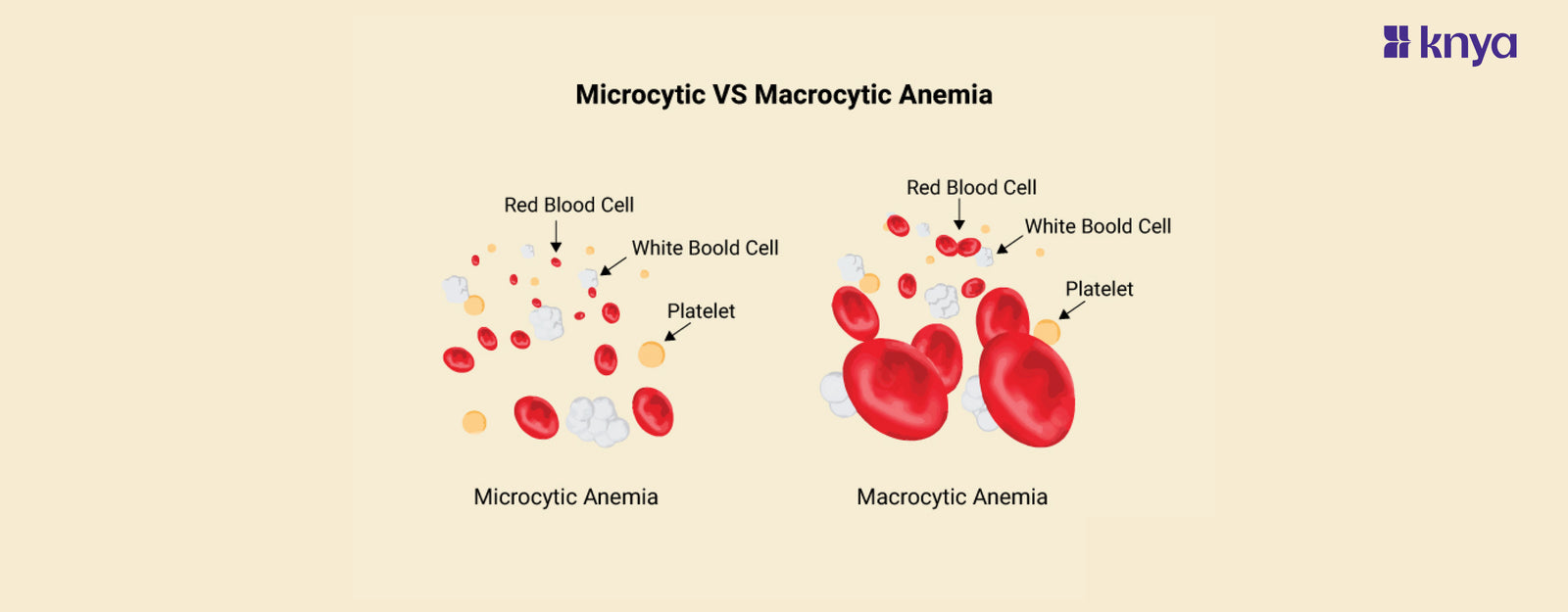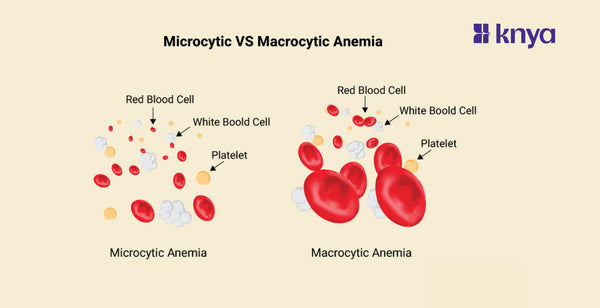Difference Between Microcytic and Macrocytic Anemia: Anemia can be defined as microcytic or macrocytic based on the size of red blood cells. Microcytic, or "small cell," refers to red blood cells that are smaller than usual owing to a lack of iron or hemoglobin, which is frequently caused by deficiencies or chronic disorders. Macrocytic, which means "large cell," occurs when red blood cells become larger than normal, usually owing to vitamin B12 or folate deficits, which influence cell division. The main distinction is in the Mean Corpuscular Volume (MCV), a blood test parameter. MCV in microcytic anemia is less than 80 fL, but in macrocytic anemia it is greater than 100 fL. Understanding the size and source of aberrant red blood cells allows for more efficient diagnosis and treatment of the root cause.
Difference Between Microcytic and Macrocytic Anemia
Microcytic and macrocytic anemias are both types of anemia characterized by abnormal red blood cell size, but they differ significantly in their underlying causes and other characteristics. Highlighting the differences between microcytic and macrocytic anemia:
|
Characteristic |
Microcytic Anemia |
Macrocytic Anemia |
|
Red Blood Cell Size |
Small (Microcytes) |
Large (Macrocytes) |
|
Causes |
Iron deficiency, thalassemia, lead poisoning |
Vitamin B12 deficiency, folate deficiency, liver disease |
|
Morphological Features |
Hypochromic red blood cells |
Hyperchromic red blood cells |
|
Mental Symptoms |
Less likely to cause neurological symptoms |
More likely to cause neurological symptoms |
|
Associated Diseases |
Iron deficiency anemia, thalassemia |
Pernicious anemia, alcoholism, liver disease |
|
Bone Marrow Appearance |
Decreased hemoglobinization of erythroblasts |
Increased numbers of large immature red blood cells |
|
Response to Supplementation |
Responds well to iron supplementation |
May require vitamin B12 or folate supplementation |
|
Maturity of Red Blood Cells |
Red blood cells tend to be more mature |
Impaired maturation or cell division may be present |
|
Associated Lab Findings |
Low serum iron levels, high total iron-binding capacity, low ferritin levels |
Low serum vitamin B12 or folate levels |
|
Underlying Mechanisms |
Related to defects in heme synthesis or iron utilization pathways |
Impaired DNA synthesis in erythroblasts |
Browse Best Scrubs Collection
What is Microcytic Anemia?
Microcytic anemia is a type of anemia in which the red blood cells (RBCs) are smaller than normal. This is often due to a lack of iron, which is essential for the production of hemoglobin, the protein that carries oxygen in the blood. Symptoms of microcytic anemia can include fatigue, shortness of breath, and pale skin.
Key Features of Microcytic Anemia:
- The hallmark of microcytic anemia is an MCV (Mean Corpuscular Volume) below 80 fL. MCV is a measure of average RBC size in a blood sample.
- Causes: The most common cause is iron deficiency, often due to insufficient dietary iron intake, blood loss, or malabsorption issues. Other causes include chronic diseases, vitamin B12 or folate deficiencies, and genetic conditions like thalassemia.
- Symptoms: Fatigue, weakness, shortness of breath, pale skin, dizziness, headaches, and cold hands and feet are common symptoms. In severe cases, heart problems and cognitive issues can occur.
- Diagnosis: A complete blood count (CBC) reveals microcytosis (low MCV) and other abnormalities like low hemoglobin and hematocrit. Further tests like iron studies, vitamin B12/folate levels, and bone marrow biopsy may be needed to determine the specific cause.
What is Macrocytic Anemia?
Macrocytic anemia is another type of anemia in which the RBCs are larger than normal. This can be caused by a deficiency of vitamin B12 or folate, which are both necessary for the production of DNA. Symptoms of macrocytic anemia can include fatigue, weakness, and tingling or numbness in the hands and feet.
Key Features of Macrocytic Anemia:
- The defining feature is an MCV (Mean Corpuscular Volume) above 100 fL. This indicates larger-than-normal RBCs in the blood.
- Causes: Vitamin B12 or folate deficiencies are the most common causes. These vitamins are crucial for DNA synthesis, and their deficiency disrupts normal RBC development, leading to larger but immature cells. Other causes include alcohol abuse, liver disease, certain medications, and rare genetic disorders.
- Symptoms: Fatigue, weakness, shortness of breath, pale skin, dizziness, headaches, and tingling/numbness in hands and feet are common complaints. Severe cases can lead to cognitive problems and nerve damage.
- Diagnosis: A complete blood count (CBC) reveals macrocytosis (high MCV) and other abnormalities like low hemoglobin and hematocrit. Further tests like vitamin B12/folate levels, liver function tests, and bone marrow biopsy may be needed to pinpoint the cause.
Shop Best Lab Coats from Here!
Similarities Between Microcytic and Macrocytic
- Symptoms of microcytic and macrocytic anemia include tiredness, weakness, pallor, shortness of breath, and palpitations.
- Both microcytic and macrocytic anemias cause impaired oxygen transport capacity due to changes in red blood cell size and/or hemoglobin concentration.
- Both kinds of anemia are diagnosed with a comprehensive clinical history, physical examination, complete blood count (CBC), and maybe further tests such as a peripheral blood smear, iron studies, vitamin B12 and folate levels, and bone marrow examination if warranted.
Microcytic and macrocytic anemias are characterized by the size of red blood cells (RBCs) as determined by mean corpuscular volume. Microcytic anemia, defined as an MCV of less than 80 fL, is characterized by smaller RBCs, which are commonly caused by iron shortage, reducing hemoglobin production. This causes weariness, pale complexion, and shortness of breath. Macrocytic anemia, defined by an MCV more than 100 fL, is characterized by bigger RBCs and is frequently caused by deficiencies in vitamin B12 or folate, both of which are required for DNA synthesis during RBC formation. Symptoms include weakness, tingling, and cognitive problems. While these anemias generate comparable symptoms such as weariness, the underlying reasons, RBC size, and treatment techniques differ greatly. Differentiating between them using MCV and further testing is critical for appropriate diagnosis and treatment.
| Check out More Articles | |
| Difference Between Cartilage and Bone | |
| Difference Between Endocrine and Exocrine Glands | |
| Difference Between Cell Wall and Cell Membrane | |















